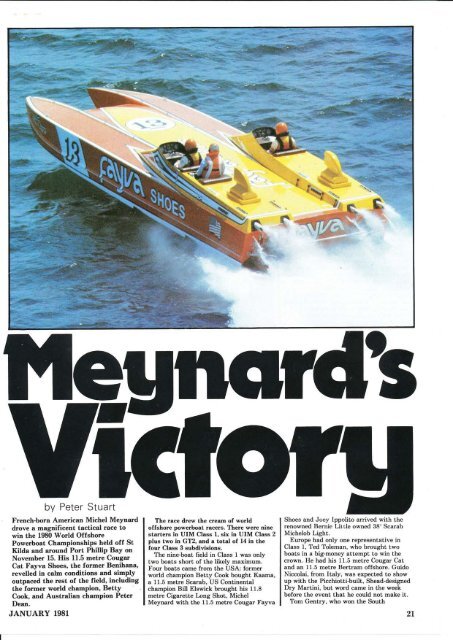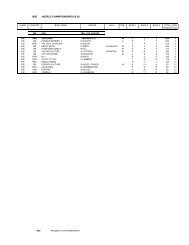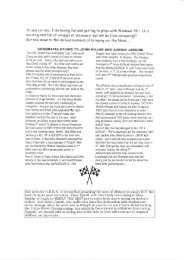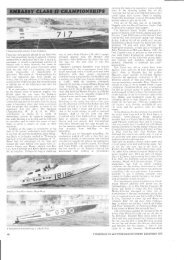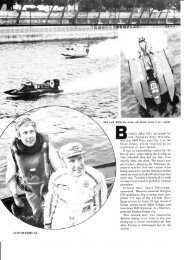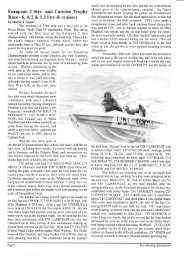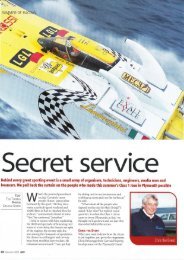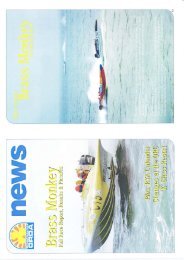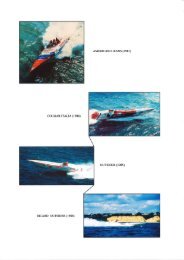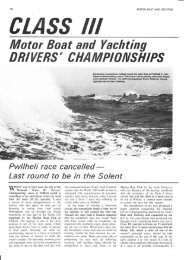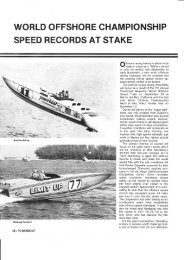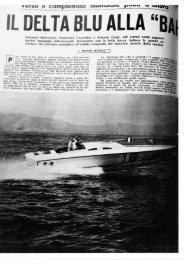by Peter Stuart - Powerboat Archive
by Peter Stuart - Powerboat Archive
by Peter Stuart - Powerboat Archive
You also want an ePaper? Increase the reach of your titles
YUMPU automatically turns print PDFs into web optimized ePapers that Google loves.
y <strong>Peter</strong> <strong>Stuart</strong><br />
French-born American Michel Meynard<br />
drove a magnificent tactical race to<br />
win the 1980 World Offshore<br />
<strong>Powerboat</strong> Championships held off St<br />
Kilda and around Port Phillip Bay on<br />
November 15. His 11.5 metre Cougar<br />
Cat Fayva Shoes, the former Benihana,<br />
revelled in calm conditions and simply<br />
outpaced the rest of the field, including<br />
the former world champion, BettY<br />
Cook, and Australian champion <strong>Peter</strong><br />
Dean.<br />
JANUARY 1981<br />
The race drew the cream of world<br />
offshore powerboat racers. There were nine<br />
starters in UIM Class 1, six in UIM Class 2<br />
plus two in GT2, and a total of 14 in the<br />
four Class 3 subdivisions.<br />
The nine-boat field in Class 1 was only<br />
two boats short of the likely maximum.<br />
Four boats came from the USA: former<br />
world champion Betty Cook bought Kaama,<br />
a 11.5 metre Scarab, US Continental<br />
champion BiIl Elswick brought his 11.8<br />
metre Cigarette Long Shot, Michel<br />
Meynard with the 11.5 metre Cougar Fayva<br />
Shoes and Joey Ippolito arrived with the<br />
renowned Bernie Little owned 38' Scarab<br />
Michelob Light.<br />
Europe had only one representative in<br />
Class 1, Ted Toleman, who brought two<br />
boats in a big-money attempt to win the<br />
crown. He had his 11.5 metre Cougar Cat<br />
and an 11.5 metre Bertram offshore. Guido<br />
Niccolai, from ltaly, was expected to show<br />
up with the Picchiotti-built, Shead-desigrred<br />
Dry Martini, but word came in the week<br />
before the event that he could not make it.<br />
Tom Gentry, who won the South<br />
2l
American Continental Series, almost didn't<br />
make it with his American Eagle 11.5 metre<br />
Scarab. The boat did not arrive <strong>by</strong> ship<br />
until Wednesday<br />
- and was off{oaded in<br />
Brisbane! It went straight on to a flat-bed<br />
truck and was rushed <strong>by</strong> road to Melbourne<br />
to arrive on the Friday afternoon, the day<br />
before the race. It left the Honolulu land<br />
developer practically no time at all to<br />
prepare the boat, and this told on him<br />
during the race.<br />
The Australian team of <strong>Peter</strong> Dean<br />
(Slingshot), Barry McMillan (Eagle) and<br />
Brian Cox (Steel-E) didn't have much in the<br />
way of difficulty in preparation, but<br />
perhaps <strong>Peter</strong> Dean wasn't happy with the<br />
way things went. He went down to the sea<br />
on the Tuesday before the race for a final<br />
workout and afterwards decided to change<br />
the engines to two new ones.<br />
New Engines<br />
The engines in the rig had done eight<br />
races, and with an effective life of only five<br />
and the knowledge that the inlernalionals<br />
use their engines only once, it can be<br />
understood that he wanted the change. On<br />
the Thursday he once again put the boat in<br />
the water, and although not entirely happy<br />
with the new engines decided there was less<br />
risk with them than the old ones.<br />
The lead-up to the race showed top<br />
organisation in keeping with the stature of<br />
the event. The Australian Offshore<br />
<strong>Powerboat</strong> Club, led <strong>by</strong> Commodore Geoff<br />
Bricker, had put thousands of man-hours<br />
into preparation for the race. The search<br />
and rescue operation included 14<br />
helicopters, numerous fixed wing aircraft<br />
and dozens of boats ranging from 36 metre<br />
tugs down to smail craft to attend the<br />
buoys and maintain station at various<br />
points around the course in case of<br />
accident. An intricate network of ham radio<br />
operators kept race control fully informed.<br />
The logistics of fuel st,orage and refuelling<br />
facilities, storage of the boats,<br />
security, publicity and organisation of<br />
social events and trophies took more time<br />
and effort but the end result was a truly<br />
professionally organised sporting event.<br />
Scrutineering and testing began on the<br />
previous Monday and continued until<br />
Thursday. On Friday briefing was held in<br />
the morning, followed at lpm <strong>by</strong> a parade<br />
of nations through the main streets of<br />
Melbourne and a civic reception given <strong>by</strong><br />
Melbourne's Lord Mayor. Throughoub the<br />
week publicity on television, radio and in<br />
the press attracted a great deal of interest<br />
despite the opposing attractions of the Kiss<br />
concert, the Australian Grand Prix at<br />
Calder and the Australian Open golf in<br />
Sydney.<br />
At practice during the week there were<br />
only two notable incidents: Italian Stefano<br />
Riva, who had chartered Tony de Fina's cat<br />
Big Bird, was put out when the boat<br />
suffered structural damage in the tunnel<br />
during a trial run, and the Fayva Shoes<br />
team had to.replace both engines after their<br />
first practice run.<br />
While Meynard was hoping for dead calm<br />
water and Ted Toleman could take it either<br />
way with his two-boat stable, the other<br />
competitors were hoping for rough water.<br />
Race day obliged Meynard. Port Phillip<br />
Bay, which can be a vicious stretch of<br />
water, turned on the charm. Only a slight<br />
ripple marred its surface, there was a light<br />
breeze and a cloudless sky held little hope<br />
of a change.<br />
First boats into the milling area, behind a<br />
mile-long chute to the starting line were the<br />
22<br />
Michel Meynard, ecstatic with his uictory<br />
15 Class 1, 2 and GT2 boats. At 10.56 two<br />
helicopters, flying in formation, took off<br />
from St Kilda foreshore and swept around<br />
in an arc to gather in the field.<br />
At 35 knots they took up station, one on<br />
each side of the chute and began the run to<br />
the line. Half-way down the chute the field<br />
was Iined up and the choppers sped up to<br />
55 knots, giving all craft good running<br />
speed as they hit the line. Right over the<br />
start buoys the choppers went into a<br />
screaming climb bo signify a start and the<br />
field was away.<br />
Within seconds the Americans and Ted<br />
Toleman asserted themselves, with Betty<br />
Cook and Kaama leading the way. Right<br />
behind her were Michelob Light and the<br />
Toleman Group boat, with Long Shot,<br />
Slingshot, American Eagle, Eagle and<br />
Fayva Shoes a little further back.<br />
The field's first turn came at Ricketts<br />
Point, where they thundered around HMAS<br />
Attack and headed for Queenscliffe.<br />
Navigation of the US boats was superb.<br />
Given the beautiful conditions, these boats<br />
were still hitting near l45km/h and you<br />
could not have ruled a straighter line than<br />
they carved across the bay. From my<br />
helicopter I could look along dead straight<br />
wakes leaving a trail of foam across the<br />
slightly rippled bay.<br />
At this stage we had dropped back in the<br />
field to look at the Class 2 boats which<br />
were being led <strong>by</strong> Queenslander Bruce<br />
Harris in Sharkies Cat. an 8.5 metre Harris<br />
Cat powered <strong>by</strong> four 175hp Mercury<br />
outboards. Sharkie was going at a<br />
tremendous pace and it was apparent that<br />
unless the water changed drastically or he<br />
had a breakdown that he would walk away<br />
withaClass2win.<br />
<strong>Peter</strong> Dean in Slingshot (who was having<br />
oil pressure problems), Barry McMillan's<br />
Eagle and Long Shot formed a spread<br />
group next up the line with the four leading<br />
boats forming a tight cluster up ahead.<br />
Slingshot was not going as well as I<br />
believed it could go, while Eagle and the<br />
heavily built Long Shot were doing as well<br />
as could be expected in conditions far from<br />
suitable. Tom Gentry in American Eagle<br />
was nowwhere to be seen: he had dropped<br />
out within minutes of the start with a<br />
broken outdrive shaft. It was a sad end for<br />
the Little South American champion who<br />
has frequently visited Australia and who<br />
had gone through so much to get his boat<br />
to the championships.<br />
Dicing for second<br />
As the boats rounded the West Channel<br />
Pile and headed for Queenscliffe Betty<br />
Cook led, with Michelob l,ight and Toleman<br />
Group dicing for second place and Michel<br />
Meynard keeping right on their hammers<br />
for fourth place. In the stretch from<br />
Queescliffe to Portsea and on to Dromana<br />
he joined the dice for second place and<br />
ultimately took it at Mornington.<br />
Before reaching the Mornington mark<br />
Michelob Light dropped out with an<br />
outdrive failure and Ted Toleman had<br />
dropped back from the leaders. As the<br />
boats rounded the Frankston mark<br />
Meynard moved to the lead in what<br />
appeared to be a move to try to con Betty<br />
Cook into going harder. Either it didn'i,<br />
work or Kaama was already flat out,<br />
because Meynard slowed and let the black<br />
and white Scarab regain the lead after only<br />
a couple of minutes.<br />
Further back in the field Slingshot had<br />
stopped with one blade missing from a<br />
propeller. Long Shot was plodding in the<br />
calm water, Eagle was making reasonable<br />
speed and Steel-E was getting further<br />
behind.<br />
As the boats headed for St Kilda to<br />
complete their first lap it had become a<br />
procession. Betty Cook led <strong>by</strong> a few<br />
seconds from Meynard. Toleman Group<br />
followed a couple of miles back, and the<br />
black and gold Cigarette, Long Shot, was<br />
still running but it was obvious all was not<br />
right with the American champion's<br />
engines. Behind him came Barry<br />
McMillan's Eagle, running smoothly but<br />
not matching it for pace with the leaders.<br />
The stop to change the prop had cost<br />
PeLer Dean a lot of time, but gamely he got<br />
back into the race to set off in pursuit of<br />
the field. However, he had not gone far<br />
when an harmonic balancer flew to pieces<br />
and set up such vibration in one engine<br />
that he could not continue and he headed<br />
back to St Kilda Marina under his own<br />
power.<br />
Not long after rounding St Kilda buoy<br />
POWERBOAT AND WATERSKIING
Slingshot became a casualty before the half-way mark<br />
the Toleman Group boat dropped out when<br />
a prop disintegrated. The race was not half<br />
over and the casualties included Slingshot,<br />
Michelob Light, Toleman GrouP and<br />
American Eagle. Within a few more<br />
minutes they were joined <strong>by</strong> Long Shot<br />
whose engines had packed it in as the field<br />
approached the West Channel pile. Long<br />
Shot had to be towed back to the marina.<br />
After rounding the West Channel pile the<br />
boats headed straight for Mornington then<br />
up the eastern side of the bay to St Kilda<br />
to complete their second lap. Nothing<br />
changed . . . it was Betty Cook in the lead,<br />
followed closely <strong>by</strong> Meynard in Fayva<br />
Shoes. Eagle was dropping further back<br />
and not far behind him was Bruce Harris in<br />
the Class 2 Sharkies Cat who was making<br />
tremendous pace.<br />
As the leaders, Kaama and Fayva Shoes,<br />
rounded the St Kilda turn and began the<br />
Iast lap which was to take them to the<br />
West Channel Pile, Ricketts Point and back<br />
td St Kilda, Meynard once again hit the<br />
front briefly before allowing Betty Cook to<br />
catch him again.<br />
Less than a minute<br />
But half-way down the first leg of the<br />
last lap the Boston shoe manufacturer<br />
decided it was time to take the lead and<br />
within a couple of miles was about a mile in<br />
front of Kaama. He then eased back<br />
slightly to maintain that distance in front<br />
of the Scarab until the boats hit the line<br />
less than a minute apart in one of the most<br />
exciting world championship finishes seen.<br />
Meynard and the Fayva Shoes crew of<br />
Bob Idon.i and Sam James had covered the<br />
180 nautical mile course (333 kilometres) in<br />
iust 2 hours 24 minutes and 57 seconds for<br />
itr urre.ag" speed of 138 km/h (85.7 mph). It<br />
was a record speed for a world<br />
championship and the third fastest offshore<br />
race speed ever recorded. Some very<br />
experienced observers believed that the<br />
distances of those supposedly faster races<br />
might be suspect because they had never<br />
seen offshore racers going as fast.<br />
Just 53 seconds behind Fayva Shoes<br />
came Betty Cook, John Connor and BiIl<br />
Vogel Jnr in Kaama. While Betty Cook was<br />
disappointed that she had not won her<br />
third world championship, she said after<br />
the race that there were no excuses<br />
- she<br />
had simply been beaten <strong>by</strong> a faster boat on<br />
the day. While that is true, because the<br />
water definitely did favour the catamaran,<br />
JANUARY T981<br />
the Ioss of substantial portions of two<br />
blades of one propeller did not help her<br />
cause. Fayva Shoes also lost the tips off<br />
propellers, but his damage was not as great<br />
as that suffered <strong>by</strong> Betty Cook's boat. In<br />
fact after the race one could seriously<br />
question the durability of the hirake<br />
propellers; Those on Fayva Shoes, Kaama<br />
and Toleman Group were damaged, and so<br />
was the prop on Slingshot.<br />
The next boat to cross the line was Barry<br />
McMillan's Eagle, with Kevin McOarroll<br />
and Cliff Pogue crewing. While Eagle is<br />
quite quick in rough conditions the flat<br />
water did not suit the 10.9 metre Cigarette<br />
one little bit and it finished just under 25<br />
minutes behind Kaama.<br />
Former world champion David Hagan,<br />
from Great Britain drove his chartered 9.7<br />
metre Cougar Cat, Raratongan/British<br />
Airways, into fifth place in 3.22.32.<br />
In Class GT2 Alan Burlock with Colin<br />
Lowry crewing, completed the course in<br />
3.07.03 for an excellent result.<br />
The Class 2 competition was excellent,<br />
but there was no beating Sharkie Harris on<br />
the day. Yet Sharkie was lucky to finish.<br />
On the Friday night a spectator noticed oil<br />
running from a lower unit while the boat<br />
was in the pits. Bearings and seals were<br />
damaged, and had Sharkie started with the<br />
problem there is no way he would have<br />
finished. Lady.Luck, glassy water and a<br />
good boat paid off for Australia's cat<br />
expert !<br />
Class 3 racing, around one lap of the<br />
course from St Kilda to Ricketts Point,<br />
West Channel Pile, Queenscliffe, Portsea,<br />
Dromana, Mornington, Frankston, Ricketts<br />
Point and back to St Kilda, turned on some<br />
really excellent competition.<br />
In Class 3D, the most powerful, Barry<br />
and Keith Lawrence performed<br />
magnificently to win <strong>by</strong> just over a minute<br />
-<br />
from the last boat in the field. The four<br />
contestants went around the course in a<br />
tight group, finishing in a bunch and<br />
causing great excitement ashore. Officially<br />
second in the class was Ian Beil<strong>by</strong> and Ian<br />
Sandford in Tackless, with New Zealandet<br />
Dick Marlo and Ron Archer in Altherm in<br />
third place and Barry Angus and Dave<br />
Grounds in Southern Cat in last place.<br />
Winning way<br />
In Class 3C <strong>Peter</strong> Ham and Keith GiIIatt<br />
in the 5.7 metre Mustang Supersteel<br />
continued on their winning way with a<br />
three minute victory over Chris Camamile<br />
and his son Wayne in their 6.9 metre<br />
Challenger Moonraker. There has been no<br />
stopping Supersteel all year, and Ham's<br />
world championship win was well deserved.<br />
In Class 38 Melbourne's <strong>Peter</strong> Bradley<br />
finished in 1.43.30 just over a minute ahead<br />
of his arch rival Malcolm Lynn from<br />
Sydney. Both drivers were running 5.1<br />
metre Minx hulls made <strong>by</strong> Bradley, with<br />
85hp Suzuki engines.<br />
The smallest class. 3A. saw a creditable<br />
and surprise win going to Brian Tootel and<br />
DaIe Watson in their 5.1 metre Minx with<br />
Carniti power, Hawki-L Throughout the<br />
year Graham Tye, from Sydney, had<br />
dominated this class in 2WL Dancraft, but<br />
in the world titles he could not match the<br />
pace of Tootel's boat and finished more<br />
than 12 minutes behind him.<br />
Following the championship a plush<br />
presentation dinner was held in the Great<br />
Hall of the Melbourne National Art Gallery.<br />
Presentations were led <strong>by</strong> the Premier of<br />
Victoria. Mr Hamer. with UIM President<br />
Francesco Cosentino presenting Class 2 and<br />
APBA President Max Roach the Class 3<br />
trophies. The function was incredibly<br />
successful in keeping with the status of the<br />
occasion and was a fitting testimonial not<br />
only to the winning drivers and all<br />
competitors, but to the work of the<br />
Australian Offshore <strong>Powerboat</strong> CIub and, in<br />
particular, the Commodore Geoff Bricker.<br />
The world championship has provided a<br />
tremendous fillip to the sport of offshore<br />
powerboat racing in Australia.<br />
The fact that Australia was so<br />
convincingly beaten <strong>by</strong> the Americans in<br />
Class I has stirred up a determination to do<br />
better. Already the AOPC has been<br />
approached with offers of assistance to<br />
send a full team to the next world<br />
championships in America.<br />
And <strong>Peter</strong> Dean and the Slingshot crew<br />
of Bruce Dean and WaI Edgar have proved<br />
that Australia has the capacity to challenge<br />
the best. Although they were beset from<br />
the outset with oil pressure problems, and a<br />
shattered prop and finally a complete<br />
engine breakdown, they did at times<br />
manage to reach top speeds that were every<br />
bit comparable with the American boats.<br />
The event and organisation was not<br />
without bugs and difficulties, but none<br />
affected the running of the race. Despite<br />
the lack of confidence shown in some<br />
international circles Oz proved they could<br />
do it, and do it well.<br />
23


